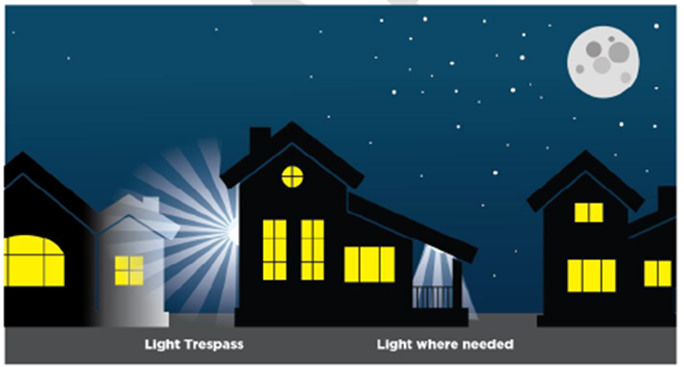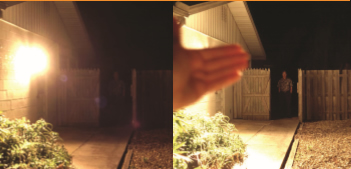Many of us have experienced this scenario: a neighbor has an unshielded fixture that casts a bright light that spills onto your property and perhaps even inside your home.
This is known as light trespass and it can cause a lot of agony and frustration. Although we don’t get involved in neighbor disputes, we have provided this resource that we hope will help you resolve your problem.

To be fair, your neighbor may not even realize that their unshielded lighting is shining on your property, wasting energy, money and creating a safety hazard.
Step 1: Is the light bothering you a violation?
The first thing to do is some research to find out if the light that is a problem for you is actually in violation of the Ivins Outdoor Lighting Ordinance. (Click here to download the Ivins City ordinance.)
Step 2: Is the light grandfathered?
If it appears the neighbor’s light is not permitted in the ordinance, it still may be permitted because there is usually a grandfathering provision exempting lighting that was in place before the ordinance was passed. The current ordinance was passed in 2007.
Step 3: If it is a violation, talk to your neighbor
Don’t hesitate to ask your neighbor for their advice or opinion in solving the problem. Goodwill goes a long way.
Many people believe that more and brighter lighting makes us safer, but there is no conclusive evidence suggesting that’s true. In fact, glare from unshielded lights can create harsh shadows where criminals can hide. And bright lighting can even make it easier for criminals to work.
See Increase Safety While Being a Good Neighbor.
So, how do you talk to your neighbor about this situation?
We suggest taking the following steps to educate your neighbor, and by extension your community, about the value of dark sky friendly lighting.
Practical Actions:
- Make friends, not enemies. Your neighbors probably don’t even realize their lighting is bothersome.
- Stay positive and don’t argue. Be tactful and understanding about your neighbor’s right to light their property.
- Suggest alternatives to their current fixture. Ask them to move the light, shield it, or add a motion sensor so it’s activated only when needed. Offer to help get this done. (Check back: we will be providing information about alternatives soon.)
- Be informative. Talking to your neighbor is an great opportunity to be an advocate for good lighting. There are many reasons to use dark sky friendly lighting. Read up on the issues regarding light pollution. In addition to the articles on the “Information” section of our website, the International Dark Sky Association (IDA) also has a number of educational resources that can be useful.
- It’s useful to know the local costs of electricity and the savings your neighbor may be able to realize. (Check back: We will upload a spreadsheet calculator soon.)
- You may also want to compile a list of local businesses or homes in the neighborhood with good quality lighting as an example of effective security measures that are dark sky friendly. (Check back: We will be providing examples soon.)
- Having a list of shielded light fixtures to provide as alternatives to your neighbor’s current lighting is also recommended. Use the IDA Fixture Seal of Approval database to find dark sky friendly fixtures and devices.
- Don’t dismiss their need to feel safe. Remember that home is a place where everyone wants to feel relaxed and safe.
- Explain that light trespass is a form of light pollution.
- Remember that everyone wants the same thing: a chance to relax in his or her own environment. Work together to create an atmosphere that benefits the community
- Write a letter. You may find it useful to put your thoughts on paper. We have provided a Sample Letter to Your Neighbor to get you started.
Step 4: Talk to us
We don’t get involved in neighbor-to-neighbor disputes, but if you have completed the first three steps above and have not resolved the problem, tell us about everything you did. We may be able to point you towards additional existing resources, or create some new information that could be useful.
If you were successful in resolving the problem, we want to hear about it. Tell us what the problem was and what you and your neighbor did to fix it. Your story, told anonymously, will help others.
Step 5: Talk to the City
If you are unable to resolve the problem after taking all of the actions above, then talk to the City. A lighting ordinance isn’t very useful if it’s not enforced. But it is important to be able to demonstrate to the City, (a) why it is a violation, and (b) all the steps you took in an effort to cooperatively resolve the problem with your neighbor.

